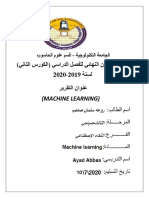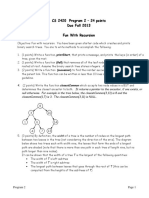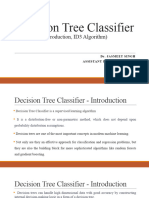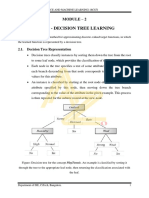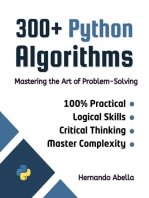ID3 Algorithm
Uploaded by
1kiprotich1ID3 Algorithm
Uploaded by
1kiprotich1ID3 algorithm
The ID3 algorithm can be summarized as follows: 1. Take all unused attributes and count their entropy concerning test samples 2. Choose attribute for which entropy is minimum (or, equivalently, information gain is maximum) 3. Make node containing that attribute The algorithm is as follows: ID3 (Examples, Target_Attribute, Attributes)
Create a root node for the tree If all examples are positive, Return the single-node tree Root, with label = +. If all examples are negative, Return the single-node tree Root, with label = -. If number of predicting attributes is empty, then Return the single node tree Root, with label = most common value of the target attribute in the examples. Otherwise Begin o A = The Attribute that best classifies examples. o Decision Tree attribute for Root = A. o For each possible value, vi, of A, Add a new tree branch below Root, corresponding to the test A = vi. Let Examples(vi) be the subset of examples that have the value vi for A If Examples(vi) is empty Then below this new branch add a leaf node with label = most common target value in the examples Else below this new branch add the subtree ID3 (Examples(vi), Target_Attribute, Attributes {A}) End Return Root
The ID3 metrics
The algorithm is based on Occam's razor: it prefers smaller decision trees (simpler theories) over larger ones. However, it does not always produce the smallest tree, and is therefore a heuristic. Occam's razor is formalized using the concept of information entropy:
Entropy
Where :
E(S) is the information entropy of the set S ; n is the number of different values of the attribute in S (entropy is computed for one chosen attribute)
fS(j) is the frequency (proportion) of the value j in the set S log2 is the binary logarithm
An entropy of 0 identifies a perfectly classified set. Entropy is used to determine which node to split next in the algorithm. The higher the entropy, the higher the potential to improve the classification here.
Gain
Gain is computed to estimate the gain produced by a split over an attribute :
Where :
G(S,A) is the gain of the set S after a split over the A attribute E(S) is the information entropy of the set S m is the number of different values of the attribute A in S fS(Ai) is the frequency (proportion) of the items possessing Ai as value for A in S Ai is ith possible value of A is a subset of S containing all items where the value of A is Ai
Gain quantifies the entropy improvement by splitting over an attribute: higher is better.
You might also like
- Decision Tree - Associative Rule MiningNo ratings yetDecision Tree - Associative Rule Mining69 pages
- Machine Learning Lab: Delhi Technological UniversityNo ratings yetMachine Learning Lab: Delhi Technological University6 pages
- CS 2420 Program 2 - 24 Points Due Fall 2013 Fun With RecursionNo ratings yetCS 2420 Program 2 - 24 Points Due Fall 2013 Fun With Recursion4 pages
- 1.when A Sparse Matrix Is Represented With A 2-Dimensional Array, WeNo ratings yet1.when A Sparse Matrix Is Represented With A 2-Dimensional Array, We6 pages
- Decision Tree Algorithm: Comp328 Tutorial 1 Kai ZhangNo ratings yetDecision Tree Algorithm: Comp328 Tutorial 1 Kai Zhang25 pages
- Decision Tree Algorithm: Comp328 Tutorial 1 Kai ZhangNo ratings yetDecision Tree Algorithm: Comp328 Tutorial 1 Kai Zhang25 pages
- Decision Tree Classifier-Introduction, ID3No ratings yetDecision Tree Classifier-Introduction, ID334 pages
- ID3 Algorithm: Abbas Rizvi CS157 B Spring 2010No ratings yetID3 Algorithm: Abbas Rizvi CS157 B Spring 201019 pages
- Day 5 Supervised Technique-Decision Tree For Classification PDF100% (1)Day 5 Supervised Technique-Decision Tree For Classification PDF58 pages
- FALLSEM2024-25 BCSE209L TH VL2024250101735 2024-07-29 Reference-Material-INo ratings yetFALLSEM2024-25 BCSE209L TH VL2024250101735 2024-07-29 Reference-Material-I48 pages
- Assignment: Course Title: Computer Algorithm Course Code: CSE 1001No ratings yetAssignment: Course Title: Computer Algorithm Course Code: CSE 100120 pages
- The Continuous Functions Techniques For Isolating The Roots of Integer PolynomialsNo ratings yetThe Continuous Functions Techniques For Isolating The Roots of Integer Polynomials13 pages













